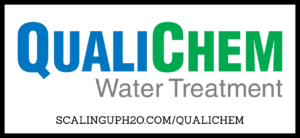“There’s no doubt that heavy metal waste streams come with a significant amount of occupational risks.”
 In this powerful episode of Scaling UP! H2O, Trace Blackmore engages with Chandler Mancuso from MacDermid Envio Solutions to share insights on this vital topic of segregating wastewater streams in heavy metals removal applications. Chandler shares his extensive expertise on the often-overlooked aspects of wastewater management, providing valuable insights into safety, strategic planning, and the power of experimentation.
In this powerful episode of Scaling UP! H2O, Trace Blackmore engages with Chandler Mancuso from MacDermid Envio Solutions to share insights on this vital topic of segregating wastewater streams in heavy metals removal applications. Chandler shares his extensive expertise on the often-overlooked aspects of wastewater management, providing valuable insights into safety, strategic planning, and the power of experimentation.
Why is Segregating Wastewater Streams Crucial?
Wastewater management is more than just treating what goes down the drain. It’s about understanding where your wastewater comes from and managing it effectively from the start. Chandler explains that his motivation for focusing on this area stems from two key factors: safety and technical insight. Heavy metal waste streams can pose significant risks, making safe handling and treatment a top priority. Chandler emphasizes the need for water professionals to fully understand the sources and composition of wastewater streams before diving into treatment processes. This strategic approach not only enhances safety but also leads to more efficient and effective solutions.
For Those New to the Industry: What is a Wastewater Stream?
A wastewater stream encompasses all the different sources of wastewater generated during various industrial processes before they reach the treatment stage. Chandler shifts the conversation from the treatment process itself to the strategy of managing these diverse streams upstream. By focusing on this early stage, water professionals can address challenges before they escalate, ensuring more efficient and effective treatment outcomes.
Understanding the Role of Heavy Metals in Wastewater
Heavy metal waste streams, which often originate from industries such as electroplating, metal finishing, and mining, can contain hazardous metals like zinc, nickel, copper, and chrome, along with other dangerous constituents like cyanide and fluoride. Properly categorizing and treating these complex streams is crucial for maintaining safety and effectiveness in wastewater treatment.
How to Ensure Health and Safety of People and Equipment
Safety is paramount when dealing with heavy metal waste streams. Chandler advises segregating incompatible waste streams to prevent dangerous reactions, such as the formation of hydrogen cyanide when cyanide-containing streams are mixed with acidic streams. By avoiding these hazardous combinations, water professionals can significantly reduce safety risks and protect both people and equipment.
Real-World Examples and Common Pitfalls
Chandler shares real-world scenarios, such as the critical need to keep cyanide-containing waste streams away from acidic conditions to prevent the formation of toxic hydrogen cyanide. Despite being well-known, these safety measures are sometimes overlooked, highlighting the importance of vigilance and thorough system design in wastewater management.
Best Practices for Wastewater Management
Never take safety for granted. Chandler encourages listeners to continuously question the conditions they are working with and to always prioritize health and safety. By remaining aware of potential hazards and continuously optimizing processes, water treaters can ensure safe and effective wastewater management.
Enhancing Efficiency and Effectiveness Through Stream Segregation
Segregation of wastewater streams is key to optimizing treatment processes. Chandler discusses how his team at MacDermid Envio Solutions has developed specific protocols for managing challenging waste streams separately, improving operational efficiency and optimizing chemical usage. This not only leads to cost savings but also enhances overall treatment effectiveness.
Experimentation: The Key to Success
Chandler highlights the importance of creative problem solving in wastewater treatment. A thorough understanding of waste streams, combined with a well-designed experimental approach, can reveal unique solutions that improve treatment outcomes. By being creative and flexible during jar testing, water professionals can uncover innovative strategies that provide significant benefits to their customers.
From Jar Testing to Real-Life Application
Translating jar testing results into real-world applications can be challenging, but it is essential for achieving practical, effective solutions. Chandler emphasizes the need for accuracy and adaptability in testing protocols to ensure a smooth transition from the lab to the field.
Timestamps
01:00 – Thank you for giving us the AWT Innovation Award for the work we do at the Scaling UP! H2O Podcast we are humbled and honored
08:20 – Catching up with returning guest Chandler Mancuso of MacDermid Envio Solutions
16:18 – The Importance of Segregating Wastewater Streams in Heavy Metals Removal Applications
50:00 – Upcoming Events for Water Treatment Professionals
51:30 – Drop by Drop With James McDonald
Connect with Chandler Mancuso
Email: chandler.mancuso@macdermidenvio.com
Website: https://www.macdermidenvio.com/
LinkedIn: www.linkedin.com/in/chandler-mancuso/
www.linkedin.com/company/macdermid-envio-solutions
Read or Download Chandler Mancuso’s Press Release HERE
Links Mentioned
Episode 064
Episode 218
Episode 269
Episode 275
Mike Rowe the S.W.E.A.T. Pledge
WEF – Water Environment Federation
AWWA – American Water Works Association
AWT – Association of Water Technologies
WEFTEC – Water Environment Federation’s Technical Exhibition and Conference
The Rising Tide Mastermind
Scaling UP! H2O Academy video courses
Submit a Show Idea
Books Mentioned
Friends, Lovers, and the Big Terrible Thing: A Memoir by Matthew Perry
Greenlights by Matthew McConaughey
How Champions Think: In Sports and in Life by Dr. Bob Rotella
Drop By Drop with James
In today’s episode, we’re thinking about an elution study. Have you ever performed one? Do you know what one is or when you would perform one? Do you have a salometer in your test kit? Have you ever just watched a water softener go through all its regeneration steps to see what happens? How do you know the brine draw step is exposing the resin bed to the correct strength of brine solution? How often should you test the brine strength during the brine draw in an elution study? Every 5 minutes, 3 minutes, or 1 minute? What if you graph your brine strength results and the curve looks different than expected? What can the shape of the elution study curve tell you about what may be wrong? An elution study isn’t usually hard to do. Coupled with observing and measuring the entire regeneration cycle and testing the makeup water for any changes, it can be a great troubleshooting tool to keep a water softener running smoothly
2024 Events for Water Professionals
Check out our Scaling UP! H2O Events Calendar where we’ve listed every event Water Treaters should be aware of by clicking HERE

